

Pathfinder_OGC. Equipment. Starting Treasure By default, we tend to think of starting characters as inexperienced beginners who have scraped together a few coins to equip themselves with mundane items for a new life of adventure.

By adjusting what beginning characters start with, you can use starting treasure to define the characters, making them part of the world they’re about to explore. Starting With Magic Items Giving each of the PCs a starting magic item makes them more robust and capable from the jump, and can be useful for smaller groups. Campaign concepts in which the characters already enjoy wealth, status, or recognition might also be reinforced with starting magic. One option is to grant the players a collective budget of 1,500 gp per person, which they can use to buy any number of magic items. Keep a close eye on what the players purchase, and veto anything that might break the game from the beginning. Be careful starting young or inexperienced players with magic items. Goods and Services.
Weapons. Without a doubt, weapons number among adventurers’ most coveted possessions.
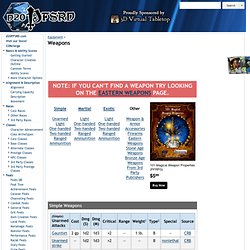
Whether weapons are used as tools to lay foul monsters low, as the medium for magical enhancements, or as outlets for a host of fundamental class abilities, few heroes head into the field without their favorite—or perhaps even a whole arsenal of their favorites. This section presents all manner of nonmagical weapons for PCs to purchase and put to use, whatever their adventures might entail. The weapons presented here should be relatively easy to find and purchase in most towns and cities, although GMs might wish to restrict the availability of some of the more expensive and exotic items. From the common longsword to the exotic dwarven urgrosh, weapons come in a wide variety of shapes and sizes.
All weapons deal hit point damage. Weapons are grouped into several interlocking sets of categories. Special Materials. Weapons, armor and some other items can sometimes be crafted using materials that possess innate special properties.
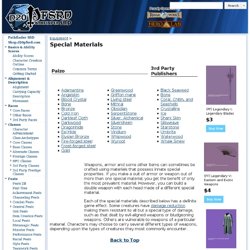
Armor and Shields. For most, armor is the simplest way to protect oneself in a world of rampant threats and dangers.
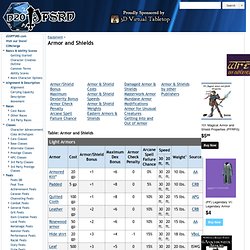
Many characters can wear only the simplest of armors, and only some can use shields. To wear heavier armor effectively, a character can select the Armor Proficiency feats, but most classes are automatically proficient with the armors that work best for them. Here is the format for armor entries (given as column headings on Table: Armor and Shields). Cost The cost in gold pieces of the armor for Small or Medium humanoid creatures. Traits. Open This in a New Window Character traits are abilities that are not tied to your character’s race or class.
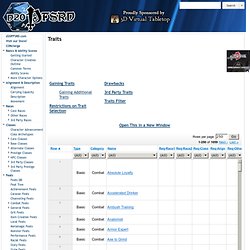
Feats. Magic. A spell is a one-time magical effect.
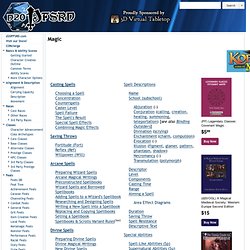
Spells come in two types: Arcane (cast by bards, sorcerers, and wizards) and Divine (cast by clerics, druids, and experienced paladins and rangers) Some spellcasters select their spells from a limited list of spells known, while others have access to a wide variety of options. Most spellcasters prepare spells in advance-whether from a spellbook or through prayers-while some cast spells spontaneously without preparation. Gamemastering. The heart of any adventure is its encounters.

An encounter is any event that puts a specific problem before the PCs that they must solve. Most encounters present combat with monsters or hostile NPCs, but there are many other types—a trapped corridor, a political interaction with a suspicious king, a dangerous passage over a rickety rope bridge, an awkward argument with a friendly NPC who suspects a PC has betrayed him, or anything that adds drama to the game. Brain-teasing puzzles, roleplaying challenges, and skill checks are all classic methods for resolving encounters, but the most complex encounters to build are the most common ones—combat encounters. When designing a combat encounter, you first decide what level of challenge you want your PCs to face, then follow the steps outlined below.
Step 1—Determine Average Party Level (APL) Determine the average level of your player characters—this is their Average Party Level (APL for short). Step 2—Determine Challenge Rating (CR) Combat. Afflictions. From curses to poisons to diseases, there are a number of afflictions that can affect a creature.
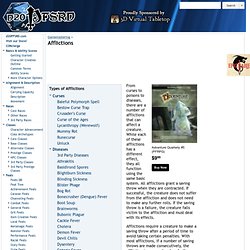
While each of these afflictions has a different effect, they all function using the same basic system. All afflictions grant a saving throw when they are contracted. If successful, the creature does not suffer from the affliction and does not need to make any further rolls. If the saving throw is a failure, the creature falls victim to the affliction and must deal with its effects. Afflictions require a creature to make a saving throw after a period of time to avoid taking certain penalties. Name: This is the name of the affliction.
Type: This is the type of the affliction, such as curse, disease, or poison. Save: This gives the type of save necessary to avoid contracting the affliction, as well as the DC of that save. Onset: Some afflictions have a variable amount of time before they set in. Cure: This tells you how the affliction is cured. Exploration & Movement. Table: Carrying Capacity Table: Armor and Encumbrance for Other Base Speeds The table below provides reduced speed figures for all base speeds from 5 feet to 120 feet (in 5-foot increments).

Table: Encumbrance Effects Table: Movement and Distance * Tactical movement is often measured in squares on the battle grid (1 square = 5 feet) rather than feet.